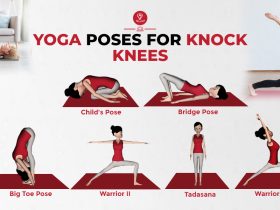
Hanumanasana, named for a figure in Hindu mythology known for his unwavering loyalty, compassion, devotion, strength and intelligence. When yogis engage in the pursuit of this pose, they connect with the essence of devotion to Hanuman.
You must have heard about the front splits, Hanuman asana is its yogic version. It is a practice in the sitting position. The intense stretch and the body balance required in it categorizes it as an advanced pose.
Hanumanasana Basics
| Sanskrit Pronunciation | Hanumanasana (hah-NU-mahn-AHS-anna) |
| Meaning | “Hanuman” = Lord Hanuman Asana = pose or posture |
| Pose Type | Seated |
| Pose Level | Intermediate Level to Advanced Level |
| Style of yoga | Modern yoga |
| Other Names | The splits pose, Front splits pose, Dragon Splits Pose |
| Stretches | Hamstrings, Quadriceps, Calves, Groins, Pelvis, Hips, Psoas |
| Strengthening | Back, Spine, Pelvic floor, Abdomen, Shoulders, Core |
| Duration | 30 second to 3 minutes |
Meaning
Hanumanasana is a Sanskrit name, where Hanuman means Hindu monkey god, and asana means yoga posture hence called Monkey Pose in English, it can be incorporated into flow yoga sequences.
The pose is an intermediate-advanced seated yoga pose, that requires lots of flexibility, strength, and stability in the hamstrings and quadriceps.
Hanumanasana Story
The mythology behind the name of this pose Hanumanasana’s comes from the Hindu monkey god Hanuman. In the epics texts- Hanuman showed his loyalty and devotion towards the King Rama of ancient India by helping him to rescue Rama’s wife, Sita. Sita was being held on the island of Sri Lanka, so Hanuman made the giant leap to reach Lanka from India.
This yoga posture the same imitates or mimics this famous jump of Hanuman (from the southern tip of India to the island of Sri Lanka). Like the jump of Hanuman, in this asana, the legs are splits forward and backward. Hence, this asana was named after Lard Hanuman as Hanumansana.
The Monkey pose is one of yoga’s most challenging postures, has a range of mental and emotional benefits as well as physical strengthening effects. Also, it is believed to stimulate the Muladhara chakra (root chakra) and Svadhisthana (spleen or sacral) chakras. Opening these chakras promotes productivity and inner acceptance.
Some asana would be beneficial in preparation for Hanumanasana -Supta Vajrasana (supine thunderbolt pose), Paschimottanasana (seated forward bend), Uttanasana, Virasana, and Supta Padangusthasana (reclining hand-to-big-toe pose).
Now, let’s learn- how to perform The Monkey pose in a step-by-step explanation, along with the benefits and precaution attached to the pose.
Practice Guide For Hanumanasana Yoga (The Monkey Yoga Pose)
The Practice Guide to Perform Hanumanasana serves as a valuable resource for yoga enthusiasts seeking to advance their practice, offering a structured and detailed approach to mastering this challenging yet rewarding yoga pose.
Preparatory Pose
- Baddha Konasana
- Janu Sirsasana
- Paschimottanasana
- Prasarita Padottanasana
- Supta Virasana
- Upavistha Konasana
- Uttanasana
- Virasana
Steps to do Hanumanasana
- To being with Hanumanasana, kneel on the floor with knees a little apart.
- Now, place your right foot forward and raise the inner sole only the outer heel touches the floor.
- Take a deep Inhale and shift your weight into the outer heel of the right foot.
- With an exhalation, slowly bend your torso forward, and bring your fingertips to touch the floor.
- After that move your left knee backward until the front of the thigh and the foot touch the floor.
- Straighten both legs the back of the right leg towards the floor and the front of the left thigh towards the floor.
- Making sure the back leg should be extending straight back so that the kneecap presses directly into the floor.
- Now raise your arms above your head with the biceps by the ears and join your palms together into Anjali Mudra.
- Stretch your arms until you are comfortable.
- If you feel discomfort place your hands down by your side.
- Stay in this position for a couple of breaths before bringing your arms back down.
- To come out this asana shift the body weight on the hands and bring the left feet in front of you. and rest DandasanaPose.
- Change the leg to repeat on the other side.
Follow-up Poses
- Eka Pada Rajakapotasana
- Upavistha Konasana
- Natarajasana
Hanumanasana Benefits
Yoga is practicing in every household since ancient times for many top benefits of yoga. Here we mention some amazing benefits of the Splits or Monkey pose.
- To know the effect of yoga on muscle strength, many yoga asanas were included, of which Hanumanasana is also one. It is believed that by doing this asana, there is a stretch in the muscles, due to which the muscles get stronger.
- This asana helps to stretch as well as strengthen the muscles in the thighs, abdominal, groin region, and hamstrings.
- Along with strengthening the muscles, one benefit of doing this asana is that it can also help in making the body flexible.
- It can also work or eliminate sciatica pain or nervous system pain. This asana also strengthens the nerves of the hands and feet.
- Regular practice will help to stimulates the abdominal organs and improves the functioning of the organs there.
- This asana works to massage the abdominal muscles and improves digestion and is also useful for removing the harmful substances from the body.
- Regular practice of Hanumanasana helps to maintain physical agility and balance, as well as increase the concentration and ability of a person to concentrate.
- This asana works to increase the flow of blood to the pelvis and also works to tone the reproductive organs. This asana reduces pelvis area tension and opens the hips or buttocks and is helpful in removing all the diseases of women like infertility, menstrual-related, and bleeding.
- Also, it is provides spiritual and energetic benefits by stimulating the Muladhara chakra (root chakra) and Svadhisthana (spleen or sacral) chakras. Opening these chakras promotes productivity and inner acceptance.
Precautions
Practicing monkey pose in the morning is often recommended by experts due to several reasons, including better digestion and higher energy levels. However, if practicing in the morning isn’t feasible for some reason, practicing in the evening can still be beneficial.
It’s important to maintain a gap of 3-5 hours between your last meal and your yoga practice, regardless of whether you’re practicing in the morning or evening. This allows for proper digestion and prevents discomfort during your practice.
Warm up: Always start with a thorough warm-up to prepare your body for deep stretching. Include gentle stretches for your hamstrings, hip flexors, quadriceps, and groin.
Use props: Props such as yoga blocks or bolsters can provide support and assistance as you work on Hanumanasana. Place them under your hands or hips for added stability.
Listen to your body: Pay attention to how your body feels in the pose. If you experience any sharp pain or discomfort, ease out of the pose immediately. It’s normal to feel a deep stretch, but you should never push yourself to the point of pain.
Those who have pain in the spine, neck, shoulder, knee, and waist, do not do this asana. One should avoid doing this asana even when seriously ill.
Conclusion
Hanumanasana yoga pose is an intermediate to advanced level or medium-grade yoga asana. As the name indicates this asana is related to Hanuman Ji. This asana is based on the same jump when Hanuman Ji jumped from the southern tip of India to Sri Lanka. In this asana, we try to bend our body like a monkey, that is why this asana is also called Monkey Pose. Helps to open the hips muscles, stretches the muscles of the abdominal and thigh joint, and also the back of the knee. Before doing this asana, do some warm-up exercises to open the hip.
The accomplishment of the asana leads to the purification of the nerves, the growth of health, and the attainment of energy. Patanjali has written in his Yogasutra “Sthiram Sukham Asanam” which means the type of sitting which keeps the mind stable and gives pleasure is called asana.
Hence, do the same variation of Hanumanasana which is comfortable for you. There may be difficulty in doing it in the beginning, but after a little practice, this asana can be done easily.
RELATED ARTICLES
May 20, 2025
Kegel Exercises: Strengthen Your Pelvic Floor for Better Health
Kegel exercises strengthen the pelvic floor muscles, which support the uterus, bladder, small intestine and rectum. Strengthening these muscles improves[...]
Oct 06, 2024
Balance Your Body: Yoga Poses For Knock Knees (Genu Valgum)
Knock knees, or “genu valgum,” is a condition in which the knees touch each other while the ankles remain apart.[...]
Sep 20, 2024
Effective Yoga Poses to Target and Reduce Armpit Fat
Fat accumulation under the arms is a common problem for many women, which is often considered an important part of[...]
RECENT POSTS
Disclaimer
The content is purely informative and educational in nature and should not be construed as medical advice. Please use the content only in consultation with an appropriate certified medical or healthcare professional







